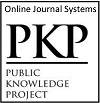IMPLEMENTING DIGITAL SIGNATURE WITH RSA AND MD5 IN SECURING E-INVOICE DOCUMENT
Abstract
Digitalisasi proses bisnis pada organisasi sudah banyak diterapkan pada era society 5.0 ini. Salah satunya yaitu digunakan pada pembuatan dokumen faktur elektronik atau disebut dengan e-invoice. Kegiatan dalam organisasi tidak terlepas dari proses transaksi yang merupakan proses bisnis utama. Oleh karena itu, pentingnya menjaga keaslian data invoice agar tidak terjadi perubahan nilai yang beresiko pada pemalsuan data invoice. Salah satu system kriptografi yang dapat memberikan layanan keamanan data berupa integrasi dan autentikasi data yang dapat mendeteksi keaslian data yaitu tanda tangan digital atau digital signature. Penelitian ini membangun digital signature dengan menerapkan fungsi hashing Message Digest 5 (MD5) dan algoritma asimetris Rivest Shamir Adleman (RSA). Simulasi penerapan digital signature pada dokumen e-invoice dilakukan dengan menggunakan software open-source kriptografi yaitu CrypTool versi 2.1. Desain simulasi sistem digital signature yaitu melalui proses hash menggunakan algoritma MD5, proses pembangkitan kunci menggunakan algoritma RSA, proses enkripsi dan dekripsi. Hasil simulasi digital signature yang dilakukan dengan menggunakan dokumen e-invoice menunjukkan hasil bahwa hasil hash dokumen MD5 dan dekripsi chipertext RSA memiliki nilai yang sama. Hal itu diartikan bahwa dokumen tersebut merupakan dokumen asli dan belum terjadi perubahan data di dalamnya.
Keywords
Full Text:
PDFReferences
Norwegian Tax Administration, “Requirements and guidelines for implementing digital signatures in Cash Register Systems,” Requir. Guidel. Implement. Digit. signatures Cash Regist. Syst., no. July, 2017.
F. Nuraeni, Y. H. Agustin, and I. M. Muharam, “Implementasi Tanda Tangan Digital Menggunakan RSA dan SHA-512 Pada Proses Legalisasi Ijazah,” Konf. Nas. Sist. Inf., pp. 864–869, 2018.
S. R. Lenka and B. Nayak, “Enhancing Data Security in Cloud Computing Using RSA Encryption and MD5 Algorithm,” vol. 2, no. 3, pp. 60–64, 2014.
R. Ganesan, M. Gobi, and K. Vivekanandan, “A novel digital envelope approach for a secure e-commerce channel,” Int. J. Netw. Secur., vol. 11, no. 3, pp. 121–127, 2010.
B. K. Hutasuhut, S. Efendi, and Z. Situmorang, “Digital Signature untuk Menjaga Keaslian Data dengan Algoritma MD5 dan Algoritma RSA,” InfoTekJar (Jurnal Nas. Inform. dan Teknol. Jaringan), vol. 3, no. 2, pp. 164–169, 2019, doi: 10.30743/infotekjar.v3i2.1019.
A. H. Mansour, I. Technology, and S. Arabia, “Journal of Soft Computing and Decision Support Systems Encryption and Decryption Analysis of the RSA Digital Signature Based on MD5 and SHA Hash Functions Using Strong Prime,” An Int. J. JSCDSS, vol. 4, no. 1, pp. 7–15, 2017.
N. Arora, Emerging Trends in Information Technology, vol. 16, no. 16. 2015.
M. Ihwani, “Model Keamanan Informasi Berbasis Digital Signature Dengan Algoritma Rsa,” CESSJournal Comput. Eng. Syst. Sci., vol. 1, no. 1, pp. 15–20, 2016.
N. Saxena and N. S. Chaudhari, “Secure encryption with digital signature approach for Short Message Service,” Proc. 2012 World Congr. Inf. Commun. Technol. WICT 2012, pp. 803–806, 2012, doi: 10.1109/WICT.2012.6409184.
E. C. Prabowo and I. Afrianto, “Penerapan Digital Signature Dan Kriptografi Pada Otentikasi Sertifikat Tanah Digital,” Komputa J. Ilm. Komput. dan Inform., vol. 6, no. 2, pp. 83–90, 2017, doi: 10.34010/komputa.v6i2.2481.
U. Somani, K. Lakhani, and M. Mundra, “Implementing digital signature with RSA encryption algorithm to enhance the data security of cloud in cloud computing,” 2010 1st Int. Conf. Parallel, Distrib. Grid Comput. PDGC - 2010, pp. 211–216, 2010, doi: 10.1109/PDGC.2010.5679895.
F. J. Aufa, Endroyono, and A. Affandi, “Security System Analysis in Combination Method: RSA Encryption and Digital Signature Algorithm,” Proc. - 2018 4th Int. Conf. Sci. Technol. ICST 2018, pp. 3–7, 2018, doi: 10.1109/ICSTC.2018.8528584.
S. Gupta, N. Goyal, and K. Aggarwal, “A Review of Comparative Study of MD5 and SSH Security Algorithm,” Int. J. Comput. Appl., vol. 104, no. 14, pp. 1–4, 2014, doi: 10.5120/18267-9305.
P. Walia and V. Thapar, “Implementation of new modified MD5-512 bit algorithm for cryptography,” Int. J. Innov. Res. Adv. Eng., vol. 1, no. 6, pp. 2349–2163, 2014, [Online]. Available: http://ijirae.com/images/downloads/vol1issue6/JYCS10080.13.pdf.
I. A. Landge and H. Satopay, “Secured IoT through hashing using MD5,” Proc. 4th IEEE Int. Conf. Adv. Electr. Electron. Information, Commun. Bio-Informatics, AEEICB 2018, pp. 1–5, 2018, doi: 10.1109/AEEICB.2018.8481007.
DOI: http://dx.doi.org/10.22373/cj.v5i2.10359
Refbacks
- There are currently no refbacks.
Copyright (c) 2021 Nurul Zaatsiyah, Djuniadi Djuniadi
except where otherwise noted.






















